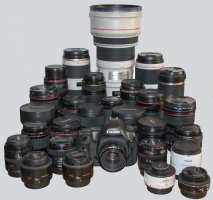jolyonralph said:
But I still think in the long term to compete with Sony and Nikon that Canon do need to look at a new system that is smaller and lighter (at least when using small primes). The 200D shows that this isn't necessarily impossible with an EF mount, but it comes down to can Canon sell the camera to *new buyers* over the Nikon or Sony offerings. Canon, rightly or wrongly, figure that their existing customers will buy what they have to offer regardless!
Okay, you believe it needs to be small to be market competitive. Understood.
But what is a new buyer? I still (strongly) believe this market -- an FF camera that is anything but a point and shoot -- is not going to be your soccer mom, hockey dad, instagrammer jumping up from cell phone, etc. and walking into a store and buying one. These are four figure investments that generally are made by folks in the know who highly likely have cameras and lenses already (though possibly with a less pricey setup, say an APS-C body with a lens or two).
As such, if you break the market into three chunks...
1) Folks who do not own an ILC
2) Existing Canon ILC users
3) Competitive ILC users
...Canon is going to go after Group #2 with all its might. They know us from a customer/expectations standpoint and they have us somewhat trapped in the brand with prior glass. We are not a hard sell. short, for Canon, it's quite possibly more profitable knocking on the same old usual customer's door than taking the risk / cost / trouble of trying to the speak the language and fulfill the expectations of the competitive user.
I'm not dismissing the notion of making a new system attractive to camp #1 above, but that's a much bigger deal for the
crop market customer, who might walk into a Best Buy, camera store, etc. and see 4-5 different companies' gear side by side. I just don't think FF buyers shop that way nearly as much.
- A

